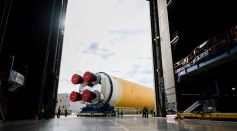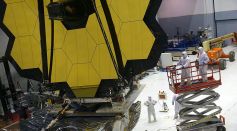Tags: NASA

NASA ’s Anti-Asteroid DART Mission Shares Its First-Ever Stunning Photos From Space

Space Shuttle Columbia Telescope Up For Sale On Craigslist For $10 Million; Here's How It Helped NASA

Webb vs Hubble Space Telescope Differences in Wavelengths, Sizes, and Orbit

NASA James Webb Space Telescope Is Ready for Christmas Launch After Series of Delays

70 Rogue Planets Found Wandering the Universe Without Being Around a Host Star

James Webb Space Telescope Launch Delayed Again, NASA to Conduct Weather Check to Confirm New Launch Date on Christmas Morning

Comet Leonardo: Watch It Head For The Sun This Christmas Week; ESA-NASA Solar Orbiter Captures Stunning Images

Russia's Only Female Cosmonaut Will Fly to ISS as Part of SpaceX's Crew-5 Mission

NASA Delays Artemis 1 Program Until March 2022 Due to Space Launch System (SLS) Rocket Engine Replacement

NASA Has Apprehensions Over Sending $10 Billion James Webb Telescope to Space, Reveals Most Complicated Activity

NASA Jet Propulsion Laboratory Confirms Mars Perseverance Rover Finds Presence of Magma, Water in Jezero Crater

NASA James Webb Space Telescope Christmas Eve Launch: Estimated Time of Departure Unveiled

NASA, SpaceX Wants to Make New Starship Launch Pad in Kennedy Space Center to Replicate Starbase

Did NASA Juno Spacecraft Just Hear Jupiter 's Moon? Here's What Happened!

James Webb Space Telescope: NASA Observatory Will Show Us How Galaxies Are Formed

NASA Perseverance Rover Collected New Rock Sample From Jezero Crater That Could Give Clues To Life on the Red Planet

NASA James Webb Telescope Launch Moved to Christmas Eve; Here's Why

NASA Announces Four Earth Science Missions in 2022 That Will Monitor the Changing Planet

NASA Parker Solar Probe Finally Kisses Sun’s Atmosphere For The First Time

Mars Sample Return Mission: NASA Begun Testing Robots That Will Collect Martian Rocks in Search of Life in the Red Planet
Most Popular

Starlink Satellite Explodes in Orbit; SpaceX Confirms It'll Re-Enter Earth

Aurora Phenomenon: How Geomagnetic Storms and Space Weather Are Lighting Up the World

Ocean Warming Explained: Why Climate Science Shows Sea Temperature Rise Is Speeding Up

How Wildfires Start, Spread, and Ignite: Understanding the Causes and Fire Behavior Clearly





